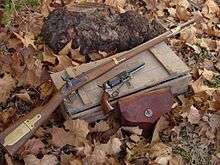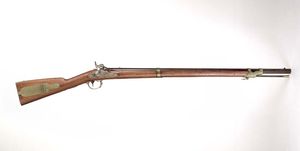M1841 Mississippi rifle
The M1841 Mississippi rifle is a muzzle-loading percussion rifle used in the Mexican–American War and the American Civil War.

| M1841 Mississippi rifle | |
|---|---|
 | |
| Type | Rifled musket |
| Place of origin | United States |
| Service history | |
| Used by | 1 Mississippi Regiment |
| Wars | Seminole Wars Mexican–American War American Civil War |
| Production history | |
| Designed | 1840 |
| Manufacturer | Harpers Ferry Armory, E. Whitney |
| Unit cost | 16 dollars |
| Produced | 1841–1861 |
| Variants | bayonet mounts |
| Specifications | |
| Mass | 9 lb 4 oz (4.2 kg) |
| Length | 48.5 in (1,230 mm) |
| Barrel length | 33 in (840 mm) |
| Cartridge | .54 ball, .58 Minie ball |
| Cartridge weight | 0.5 oz (14 g) |
| Caliber | 0.54, 0.58 |
| Action | percussion lock |
| Rate of fire | 2-3 per minute |
| Muzzle velocity | 1,000 to 1,200 feet per second |
| Effective firing range | 0-1100 yards |
| Maximum firing range | 2000 |
| Feed system | muzzle |
| Sights | blade (front), V-notch, leaf, ladder sight (rear) |
History
When Eli Whitney Blake took over management of the Harpers Ferry Armory in 1842, he set about tooling up under his new contract from the U.S. government for making the model 1841 percussion rifle. Machinery and fixtures for making the 1822 contract flintlock musket had to be retooled or replaced in order to produce the lock and barrel of the new model. Whitney, Jr. had the good sense to hire Thomas Warner as foreman, who, as master armorer at Springfield Armory, had just been making the same kind of major changes there. Thomas Warner had spearheaded the drive to equip the Springfield Armory with a set of new, more precise machines, and a system of gauging that made it possible to achieve, in the late 1840s, the long-desired goal of interchangeability of parts in military small arms. (John H. Hall had been the first to accomplish this with the US Rifle Model 1819, which had previously achieved parts interchangeability at Harpers Ferry by the mid-1820s.) Under Warner's tutelage, Eli Whitney, Jr. equipped the Whitney Armory to do likewise.
The nickname "Mississippi" originated in the Mexican–American War when future Confederate president Jefferson Davis was appointed Colonel of the Mississippi Rifles, a volunteer regiment from the state of Mississippi. Colonel Davis sought to arm his regiment with Model 1841 rifles. At this time, smoothbore muskets were still the primary infantry weapon, and any unit with rifles was considered special and designated as such. Davis clashed with his commanding officer, General Winfield Scott, who said that the weapons were insufficiently tested and refused the request. Davis took his case to President James K. Polk, who overruled Scott and endorsed Davis' request. The incident started a lifelong feud between Davis and Scott.[1]
The Model 1841 was replaced by the minie ball firing Springfield Model 1855, which became the standard issue weapon for regular army infantry, and ultimately the Springfield Model 1861 and Model 1863.
By the time of the Civil War, the Mississippi rifle was generally considered old-fashioned but effective. In the rush to arm troops in 1861, many new soldiers considered themselves fortunate to have any rifled arm while many of their comrades carried smoothbore muskets. It was carried by some Union troops up until at least 1863 (the 45th New York Infantry was still armed with theirs until after Gettysburg). Some Confederate cavalry and sharpshooter units used them until the end of the war, as evidenced by surviving Confederate ordnance requisitions.
The Mississippi rifle was sometimes referred to as a "yagger" rifle, due to its smaller size and its similarity to the German Jäger rifles.
Design and features
The Mississippi rifle was the first standard U.S. military rifle to use a percussion lock system. Percussion lock systems were much more reliable and weatherproof than the flintlock systems that they replaced, and were such an improvement that many earlier flintlock rifles and muskets were later converted to percussion lock systems.
The Mississippi rifle was originally produced in .54 caliber, using 1:66 rifling and no provision for fixing a bayonet.
In 1855, the Mississippi rifle was changed to .58 caliber, so that it could use the .58 caliber Minie Ball that had recently become standard. Many older Mississippi rifles were re-bored to .58 caliber. The rifle was also modified to accept a sword type bayonet.
The first Mississippi rifles had a v-notch sight. This was later replaced with leaf sights with 100, 300, and 500 yard ranges. A ladder sight with ranges from 100 to 1100 yards in 100 yard increments was fitted on some later rifles.
References
- p.2 Taylor, John M. Compassion is Always Due to an Enraged Imbecile in ''While Cannons Roared 1997 Brasseys
- Brown, Stuart E., The Guns of Harpers Ferry, Baltimore, Md.: Clearfield Co., 2002, 1968., 157 p., ISBN 0-8063-4640-X
- "Confederate Tales of the War" By Michael E. Banasik
External links
- Mississippi Rifle - article on the rifle from the National Museum of American History